View in other NatureServe Network Field Guides
NatureServe
Montana
Utah
Wyoming
Idaho
Wisconsin
British Columbia
South Carolina
Yukon
California
New York
Woolly Clover - Trifolium microcephalum
General Description
Plants: Annuals with a fibrous root system and up to several stems. Stems erect to prostrate with ascending tips, 10-70 cm in length (Douglas et al. 1999); herbage villous to hirsute (Lesica 2012), densely so on the bottom of the involucre and top of the peduncle (Barneby 1989).
Leaves: Palmately compound, alternate (Douglas et al. 1999); leaflets 3, 5-16 mm in length, 2.5-9 mm in width (Barneby 1989), obovate, the margins serrate distally; stipules 5–10 mm long, lanceolate, adnate to the petiole (Lesica 2012), the margins smooth to shallowly toothed (Barneby 1989), occasionally with a bristle tip (Douglas et al. 1999); petioles usually 1-4.5 cm in length, although the far distal ones may be shorter (Barneby 1989).
Inflorescences: Racemes axillary, 5–10 mm long, longer than the leaves, subtended by a villous, saucer-shaped involucre of partially fused bracts (Lesica 2012); involucre 5-12 mm across, split about halfway into 5-11 lobes; lobes entire to 3-toothed (Barneby 1989), papery, bristle-tipped and typically untoothed (Douglas et al. 1999); heads a half-sphere becoming ovoid, each with about 7-40 flowers (Barneby 1989).
(Lesica’s contribution adapted from
Lesica et al. 2012. Manual of Montana Vascular Plants. BRIT Press. Fort Worth, TX)
Phenology
Flowering June-August (Barneby 1989).
Diagnostic Characteristics
Resembles White-tip Clover (T. variegatum) in structure, habit, and flower-head size, and is associated with it in wet meadows. However, Woolly Clover has long, soft hairs nearly all over, thickly so at the uppermost part of the peduncle and bottom of the involucre, and usually just a single seed. White-tip Clover is glabrous and usually 2 seeded (Barneby 1989).
Species Range
Montana Range
Range Descriptions
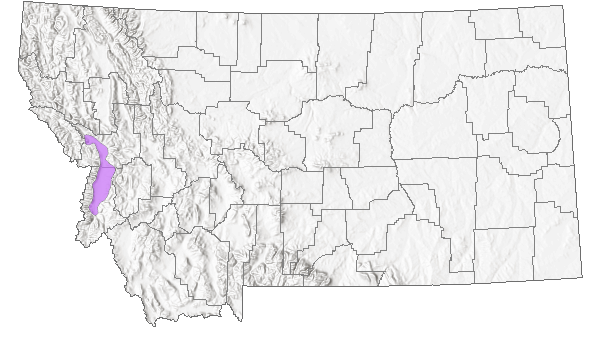
 Native
Native
Range Comments
BC, MT south to CA, AZ and Mexico. In Montana, known in Missoula and Ravalli counties (Lesica et al. 2012. Manual of Montana Vascular Plants. BRIT Press. Fort Worth, TX).
Observations in Montana Natural Heritage Program Database
Number of Observations: 11
(Click on the following maps and charts to see full sized version)
Map Help and Descriptions
Relative Density
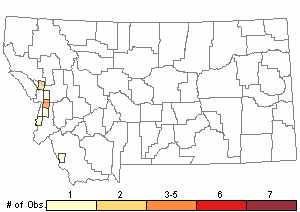
Recency
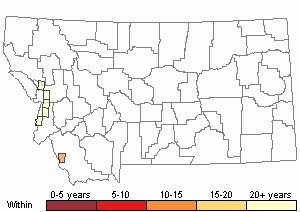
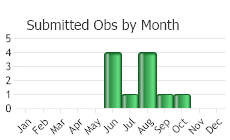
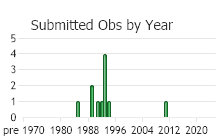
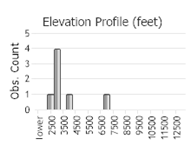 (Observations spanning multiple months or years are excluded from time charts)
(Observations spanning multiple months or years are excluded from time charts)
Habitat
Moist meadows (Barneby 1989), sandy banks along rivers to dry hillsides (Hitchcock et al. 1961).
National Vegetation Classification System Groups Associated with this Species
Wetland and Riparian
Riparian and Wetland Forest
Wet Meadow and Marsh
Ecology
POLLINATORS The following animal species have been reported as pollinators of this plant species or its genus where their geographic ranges overlap:
Bombus vagans,
Bombus appositus,
Bombus auricomus,
Bombus bifarius,
Bombus borealis,
Bombus centralis,
Bombus fervidus,
Bombus flavifrons,
Bombus frigidus,
Bombus huntii,
Bombus melanopygus,
Bombus mixtus,
Bombus nevadensis,
Bombus rufocinctus,
Bombus sylvicola,
Bombus ternarius,
Bombus occidentalis,
Bombus pensylvanicus,
Bombus bimaculatus,
Bombus griseocollis,
Bombus impatiens,
Bombus insularis,
Bombus suckleyi,
Bombus bohemicus,
Bombus flavidus, and
Bombus kirbiellus (Plath 1934, Hobbs 1966, Macior 1974, Heinrich 1976, Bauer 1983, Thorp et al. 1983, Mayer et al. 2000, Rao and Stephen 2007, Wilson et al. 2010, Colla and Dumesh 2010, Colla et al. 2011, Koch and Strange 2012, Koch et al. 2012, Miller-Struttmann and Galen 2014, Williams et al. 2014).
Reproductive Characteristics
Flowers: Flowers white to pink, 4–5 mm long; calyx villous basally, 3-5 mm in length, nearly as long as the corolla (Lesica 2012), the tube with 10 ribs and 1.6-2.3 mm in length, the teeth triangular and spine-tipped, entire and ca 1.5-3 mm in length (Barneby 1989).
Fruit: Legume obovoid to oval, 1.5-2 mm in length, the valves weakly networked with ridges or slightly gritty distally, enclosing 1 (Barneby 1989) or 2 seeds (Lesica 2012).
(Lesica’s contribution adapted from
Lesica et al. 2012. Manual of Montana Vascular Plants. BRIT Press. Fort Worth, TX)
Stewardship Responsibility
Threats or Limiting Factors
STATE THREAT SCORE REASON
Reported threats to Montana's populations of Woolly Clover include threats due to exotic species and associated risks from herbicide application (MTNHP Threat Assessment 2021). Common St. John's-wort (Hypericum perforatum), Leafy Spurge (Euphorbia virgata), Spotted Knapweed (Centaurea stoebe), and exotic grasses occur with some populations. Chemical herbicide is applied to control co-occurring noxious species and likely inflicts additional stress at these populations.
References
- Literature Cited AboveLegend:
 View Online Publication
View Online Publication Barneby, R.C., A. Cronquist, A.H. Holmgren, N.H. Holmgren, J.L. Reveal, P.K. Holmgren. 1989. Fabales. Intermountain Flora: Vascular Plants of the Intermountain West, U.S.A. Volume 3, Part B. Bronx, NY: New York Botanical Garden. 279 pp.
Barneby, R.C., A. Cronquist, A.H. Holmgren, N.H. Holmgren, J.L. Reveal, P.K. Holmgren. 1989. Fabales. Intermountain Flora: Vascular Plants of the Intermountain West, U.S.A. Volume 3, Part B. Bronx, NY: New York Botanical Garden. 279 pp. Bauer, P.J. 1983. Bumblebee pollination relationships on the Beartooth Plateau tundra of Southern Montana. American Journal of Botany. 70(1): 134-144.
Bauer, P.J. 1983. Bumblebee pollination relationships on the Beartooth Plateau tundra of Southern Montana. American Journal of Botany. 70(1): 134-144. Colla, S., L. Richardson, and P. Williams. 2011. Bumble bees of the eastern United States. Washington, DC: USDA Forest Service, Pollinator Partnership. 103 p.
Colla, S., L. Richardson, and P. Williams. 2011. Bumble bees of the eastern United States. Washington, DC: USDA Forest Service, Pollinator Partnership. 103 p. Colla, S.R. and S. Dumesh. 2010. The bumble bees of southern Ontario: notes on natural history and distribution. Journal of the Entomological Society of Ontario 141:39-68.
Colla, S.R. and S. Dumesh. 2010. The bumble bees of southern Ontario: notes on natural history and distribution. Journal of the Entomological Society of Ontario 141:39-68. Douglas, G.W., D. Meidinger, and J. Pojar, editors. 1999. Illustrated Flora of British Columbia. Volume 3. Dicotyledons (Diapensiaceae through Onagraceae). British Columbia Ministry of Environment, Lands and Parks, and British Columbia Ministry of Forests, Victoria.
Douglas, G.W., D. Meidinger, and J. Pojar, editors. 1999. Illustrated Flora of British Columbia. Volume 3. Dicotyledons (Diapensiaceae through Onagraceae). British Columbia Ministry of Environment, Lands and Parks, and British Columbia Ministry of Forests, Victoria. Hobbs, G.A. 1966b. Ecology of species of Bombus Latr. (Hymenoptera: Apidae) in southern Alberta. V. Subgenus Subterraneobombus Vogt. Canadian Entomologist 98: 288-294.
Hobbs, G.A. 1966b. Ecology of species of Bombus Latr. (Hymenoptera: Apidae) in southern Alberta. V. Subgenus Subterraneobombus Vogt. Canadian Entomologist 98: 288-294. Koch, J., J. Strange, and P. Williams. 2012. Bumble bees of the western United States. Washington, DC: USDA Forest Service, Pollinator Partnership. 143 p.
Koch, J., J. Strange, and P. Williams. 2012. Bumble bees of the western United States. Washington, DC: USDA Forest Service, Pollinator Partnership. 143 p. Koch, J.B. and J.P. Strange. 2012. The status of Bombus occidentalis and B. moderatus in Alaska with special focus on Nosema bombi incidence. Northwest Science 86:212-220.
Koch, J.B. and J.P. Strange. 2012. The status of Bombus occidentalis and B. moderatus in Alaska with special focus on Nosema bombi incidence. Northwest Science 86:212-220. Lesica, P., M.T. Lavin, and P.F. Stickney. 2012. Manual of Montana Vascular Plants. Fort Worth, TX: BRIT Press. viii + 771 p.
Lesica, P., M.T. Lavin, and P.F. Stickney. 2012. Manual of Montana Vascular Plants. Fort Worth, TX: BRIT Press. viii + 771 p. Macior, L.M. 1974. Pollination ecology of the Front Range of the Colorado Rocky Mountains. Melanderia 15: 1-59.
Macior, L.M. 1974. Pollination ecology of the Front Range of the Colorado Rocky Mountains. Melanderia 15: 1-59. Mayer, D.F., E.R. Miliczky, B.F. Finnigan, and C.A. Johnson. 2000. The bee fauna (Hymenoptera: Apoidea) of southeastern Washington. Journal of the Entomological Society of British Columbia 97: 25-31.
Mayer, D.F., E.R. Miliczky, B.F. Finnigan, and C.A. Johnson. 2000. The bee fauna (Hymenoptera: Apoidea) of southeastern Washington. Journal of the Entomological Society of British Columbia 97: 25-31. Miller-Struttmann, N.E. and C. Galen. 2014. High-altitude multi-taskers: bumble bee food plant use broadens along an altitudinal productivity gradient. Oecologia 176:1033-1045.
Miller-Struttmann, N.E. and C. Galen. 2014. High-altitude multi-taskers: bumble bee food plant use broadens along an altitudinal productivity gradient. Oecologia 176:1033-1045. MTNHP Threat Assessment. 2021. State Threat Score Assignment and Assessment of Reported Threats from 2006 to 2021 for State-listed Vascular Plants. Botany Program, Montana Natural Heritage Program, Helena, Montana.
MTNHP Threat Assessment. 2021. State Threat Score Assignment and Assessment of Reported Threats from 2006 to 2021 for State-listed Vascular Plants. Botany Program, Montana Natural Heritage Program, Helena, Montana. Plath, O.E. 1934. Bumblebees and their ways. New York, NY: Macmillan Company. 201 p.
Plath, O.E. 1934. Bumblebees and their ways. New York, NY: Macmillan Company. 201 p. Rao, S. and W.P. Stephen. 2007. Bombus (Bombus) occidentalis (Hymenoptera: Apidae): In decline or recovery. Pan-Pacific Entomoligist 83(4): 360-362.
Rao, S. and W.P. Stephen. 2007. Bombus (Bombus) occidentalis (Hymenoptera: Apidae): In decline or recovery. Pan-Pacific Entomoligist 83(4): 360-362. Thorp, R.W., D.S. Horning, and L.L. Dunning. 1983. Bumble bees and cuckoo bumble bees of California (Hymenoptera: Apidae). Bulletin of the California Insect Survey 23:1-79.
Thorp, R.W., D.S. Horning, and L.L. Dunning. 1983. Bumble bees and cuckoo bumble bees of California (Hymenoptera: Apidae). Bulletin of the California Insect Survey 23:1-79. Williams, P., R. Thorp, L. Richardson, and S. Colla. 2014. Bumble Bees of North America. Princeton, NJ: Princeton University Press. 208 p.
Williams, P., R. Thorp, L. Richardson, and S. Colla. 2014. Bumble Bees of North America. Princeton, NJ: Princeton University Press. 208 p. Wilson, J.S., L.E. Wilson, L.D. Loftis, and T. Griswold. 2010. The montane bee fauna of north central Washington, USA, with floral associations. Western North American Naturalist 70(2): 198-207.
Wilson, J.S., L.E. Wilson, L.D. Loftis, and T. Griswold. 2010. The montane bee fauna of north central Washington, USA, with floral associations. Western North American Naturalist 70(2): 198-207.
- Additional ReferencesLegend:
 View Online Publication
View Online Publication
Do you know of a citation we're missing? Lesica, P., M.T. Lavin, and P.F. Stickney. 2022. Manual of Montana Vascular Plants, Second Edition. Fort Worth, TX: BRIT Press. viii + 779 p.
Lesica, P., M.T. Lavin, and P.F. Stickney. 2022. Manual of Montana Vascular Plants, Second Edition. Fort Worth, TX: BRIT Press. viii + 779 p. Quire, R.L. 2013. The sagebrush steppe of Montana and southeastern Idaho shows evidence of high native plant diversity, stability, and resistance to the detrimental effects of nonnative plant species. M.Sc. Thesis. Bozeman, MT: Montana State University. 124 p.
Quire, R.L. 2013. The sagebrush steppe of Montana and southeastern Idaho shows evidence of high native plant diversity, stability, and resistance to the detrimental effects of nonnative plant species. M.Sc. Thesis. Bozeman, MT: Montana State University. 124 p.
- Web Search Engines for Articles on "Woolly Clover"





